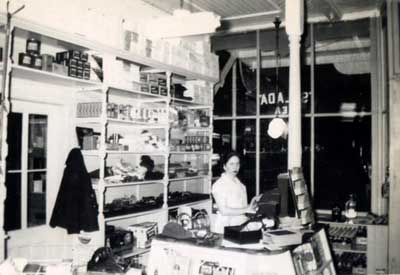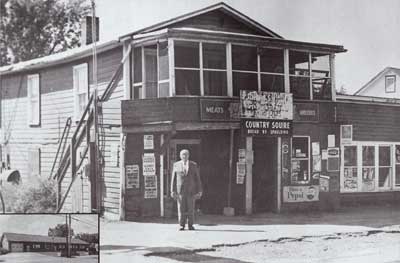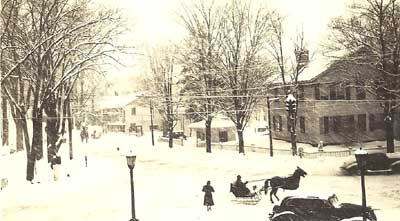subscription newsletter text and photos are here
past newsletters are available at: http://www.dteator.com/glhg/glhg.htm


Grapeville General Store - 1950s (M. Snow)
Goldie Winn, Grapeville General Store (M. Snow)


John I Ver Planck, 1969, just before store is razed
Greenville four corners, photo for 2015 calendar (C. Adriance)
“Local history at its best,”
I muttered to myself, as I closed the outside door to the library. And
then with a smile, “Again.”
It seems we have pulled off some quality programs these last three
years, and tonight’s ranked in good company.
As for attendance, I’ll save that for the end.
This program started as a seed, planted by several of
you, several years ago. “We should do a program on
general stores,” is what I heard. So, when Maureen had her
article published in the Greene County Historical Society Journal, and
after I pondered how we might do a local version, I took your advice and
started planning.
So, the original idea was to focus on John I’s, with a short
review of all the other stores we could remember. But, earlier in the
year, when Marilyn Snow hinted there might be some Grapeville Store
material to consider, and after I received an email with about 100
attachments, I realized that the two stores would be plenty for one
program. Perhaps we can still do the others some other night next year or
the year after.
And we have the great fortune to have second-generation connections
with both stores. So, Maureen and Jack Ver Planck represented
his parents, and Marilyn Winn Snow
represented her parents, Goldie and Harold Winn; it is as good as local
history can get thirty or fifty years after the fact.
And then add Zan Bryant and Millie Gipprich (both are Winn cousins)
and the stories were further enriched.
With Don at the projector controls for Maureen’s
fifteen slides and then Marilyn’s eighty slides, the program started.
Maureen started the John I history with
a little family background. John I’s father was Isaac (married Lillian
Ingalls) who owned a wagon-making business (featured in a past calendar).
When Isaac died (1912), Lillian asked her son-in-law Bert Bell to run the
business, which he did for almost ten years.
In 1922, with the fate of horse-drawn carriages mostly decided by
the Model-T, Bert sold the business back to John I who is now about 20
years old. (Everyone called him John I, probably from his mother calling
him that ever since he was a child.)
John I started selling groceries, adding an addition here and
there, taking on more types of wares. He would marry Viola in 1931 (side
story: she liked ice cream, so when she was behind the soda fountain
counter, ample portions were served, prompting John I to claim he lost
money when his wife ran the counter).
In the side room, John I hosted dancing and boxing, and claimed he
felt the best he ever had in his life when he boxed.
If he did not have what the customers wanted, John I would refer
them to a store that might, even if it was Powell Store a few buildings
away. The reverse also happened.
By the time John
I’s son Jack was born in 1938, you could find almost anything in
John’s store – even if it took more than a moment to find it. If
you couldn’t find it, all you had to do was ask John – he had a memory
where everything and anything had been placed. His computational skills
were legendary; he would total in his head, and the customer, upon
arriving home and checking out the numbers, would find John I’s numbers
correct again.
Maureen asked the audience for their memories—types
of goods, lighting, smells, etc.
Some of those memories were the friendliness of John I, the smell
of floor stain, the strong skunk smell one year (the details of how it
happened are told a couple different ways), WWII and rationing, adding the
butcher market, living in the upstairs apartment (until 1946 when John I
bought back the old farm), the barbershop upstairs, getting gas at the
pumps, buying a radio or kitchen appliance, feed, suspenders, and
practically anything else. And home delivery was often done. The only TV
for some was the one in John I’s store, and the crowd would gather,
until a family purchase was made.
In 1963, John I
moved out of the General Store into the appliance business with his son
Jack. In 1969, they razed the old wagon shop/general store to build
a furniture showroom, forming VerPlanck’s Appliance and Furniture
business.
John I passed away
in 1982, leaving behind a legendary aura that will be remembered as long
as there are people alive to relive their experiences.
So, we wrapped up
the VerPlanck account, reminding the audience that John I’s sister’s
son, Harold Bell, ran a store in Westerlo with his wife. And through
his sister’s marriage to Bert Bell, he was connected to Ernie Bell who
owned the Medusa General Store.
This theme of family
connections continued as we shifted gears for Marilyn Snow’s
account.
Marilyn’s
dad was Harold Winn, brother to Ezra who owned the store in South
Westerlo, the same one that was joined by Al Bryant, and of course that
leads to the Bryant’s Supermarket connection years later. Ezra also
owned the Grapeville store until he sold it to his brother Harold.
Marilyn kept up a fast pace narrative, showing family, buildings,
receipts, interior shots, and the Bronck House Grapeville exhibit
(currently not accessible for lack of volunteer time). Her family sold the
store in 1956, the store lasting only a short time longer before closing
for good. Years later, the Labuda family bought the building; today, the
time-worn building is standing on its last legs. In addition, Marilyn gave
a brief history of part of Grapeville’s past, an interesting look at a
small hamlet that garners little attention today.
Marilyn’s grandfather George had
owned a blacksmith shop/store in Grapeville, the store that would become
Labuda’s (practically next door). Perhaps, one can credit Grandpa George
with passing down those shopkeeper “genes” to his children and beyond.
According to Marilyn, the Grapeville Store, like other general
stores, “sold everything from nails to snow boots to children's sleds (I
still have mine) to paint to thread (I believe the thread case in in the Bronck
House Museum…) to freshly cut meats to Revere cookware to
tools.”
Attendance was, well…,
awesome. Several trickled in before 7:15, then a few more, and a few more,
and empty chairs started disappearing, and then a few more came in, and
then several of you helped carry about twenty chairs from the small
Community Room. My best estimate was about sixty. Between my own sparse
notes (too occupied otherwise) and the optional sign-in, I believe these
people were in attendance:
Lois Rockefeller, Beverly
Moore, Ann & Bob Hallock, Carolyn Savery, Mildred Gipprich, Sue &
Lew Knott, Marie & Bob Shaw, Sherry Baron, Donna & Walt Ingalls,
Mary & Allyn Shaw, Rachel Ceasar, Richard Ceasar, Wanda & David
Dorpfeld, Lynda Pisano & Ross Burhouse, Debbie Magee, Marilyn &
Richard Snow, Robert Tauckus, Barbara & Flip Flach, Margaret Donohue,
Kathy & John McAneny, Sonia Greiner, Lori Blair, Bette Welter, Mary
Heisinger, Christine Mickelsen, Karen Bolte, Judy & Dave Rundell,
Phyllis Beechert, Zan Bryant, Maureen & Jack Ver Planck, Johanne &
Robert Titus, Stephanie Ingalls, Ron Golden, Dave Tschinkel, Don Teator,
and I know missed more. If I missed, and you want to let me know, either
to note next time, or just to let me know, let me know.
Thank you, Stephanie and
Christine, for furnishing refreshments! Much appreciated.
And a thank you
goes to the several of you who helped put up chairs and clean up at
meeting’s end. What a helpful cast.
The October 13th
meeting will feature the 2015 GLHG Calendar, unveiled for the first
time this evening. The preliminaries will include a slide show of two
photos of each of the first 19 calendars. (Actually, I had help. Stephanie
made the selections, I will narrate, and I invite all of you to pitch in
as you desire.) Over the years, the calendars have captured a wide array
of local history, and so many of you have helped—sharing, alerting me,
donating.
Then we will take time to examine this year’s calendar, field
questions, offer connections, etc.
The cost will be the same as last year—$9 per calendar at the
businesses that have kind enough to help us, and I hope will help us again
this year again.
For the evening, the special will be $7 for those attending. There
may even be a three-for special.
If anyone can help sell calendars, either personally or through
other venues, it will be appreciated. Breaking even is always a goal,
having done it last year for the first time in quite some time.
I will have a list of establishments where calendars are available
in the next newsletter.
Audrey Matott’s Daily Mail article about the lesser known corners of the town was available for your perusal.
Local History question: I was asked if I knew where “Jackass Hollow” was. I have heard of the name but cannot place it. If you know, let me know and I will pass the info on. (I was thinking in the Medway-Honey Hallow area.)
Lew Knott donated a December 29, 1932 copy of The Examiner (a Greene County publication) for the files. The story that caught my eye was the dedication of the new GCS building, the copy of which I will include in a future email. Also, this issue contained a Chronology of 1932. The editorial mentions the chronology, stating they took information from fifty different columnists. The areas included in this issue were: Catskill, Athens, Lambs Corners, Earlton, Westerlo, Green Lake, Cairo, Cornwallville, Durham, Hannacroix, West Medway, Greenville, Lampman Hill, New Baltimore, Athens, and a contingent listed under the heading of Catskill Mountain Section: East Jewett, Little Westkill, Hunter, Hensonville, Haines Falls, Lexington, Westkill, Tannersville, Beaches Corner, West Jewett & North Lexington, and Goshen Street. I wonder which places were not in this issue?
Program selection, mostly by default, has become my responsibility. As I look ahead to next year, I should remind you that my decisions are a whole lot better if I get some feedback about program ideas that would be of interest. So, keep on suggesting. (Someone mentioned Greenville cemeteries.)
It’s that time of the year when we talk about GLHG
Recognition for the calendar of the year following (2016).
I have an idea which I hope is agreeable to you. In last year’s voting,
we took the first and second vote-getters, the tally practically tied.
However, just behind, the third place vote getter(s) was/were
substantially ahead of the rest of the vote-getters, and I am suggesting
we select that person(s) for 2016. If so, then we will get serious about
generating a new list for 2017.
If you feel we should do something different this year, let me
know, and we will try to tackle the selection soon. (Honestly, if only one
or two people want something different, I will obviously respect the
opinion, keep it in mind, but will probably consider the silence from the
rest as acceptance of the process for the 2016 calendar.) If you want an
opinion to count, whether in acceptance or wanting an alternative, let me
know soon. Email, phone, or mail by the week after our October meeting.
I visited Durham Center Museum late summer – as always, a worthy visit. Sancie & Doug Thomsen keep a tradition alive. One of the features is a collection of photos taken in the 1980s mostly, I think, of groups of customers at Hollowbrook Restaurant. You are invited to stop in and to try to identify who are in the photos (about 20 albums). DCM is open Fri-Sun afternoons through Columbus Day Weekend so try to get there soon, if you are interested.
And for those who wanted to know the weather for meeting day. It was an almost perfect, 70s, mostly sunny day, with a pleasant evening, the quintessential September day.
Take care,
-Don